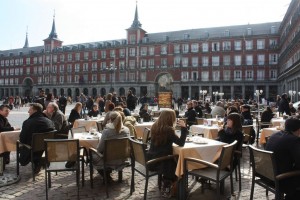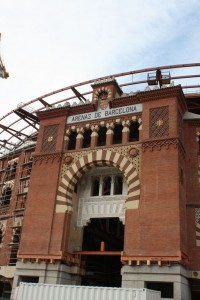#spain travel
#
Madrid

 Spain’s capital, Madrid. is the epicentre of Spanish history, fine arts and architecture. It is a stronghold of traditions where centuries-old buildings and monuments stand strong. At the same time, it has maintained a balance between the old and the new, continuing to exhibit gorgeous classical architecture alongside modern, avant-garde structures. Literally located in the middle of the country, it is a great take-off point for exploring the nation.
Spain’s capital, Madrid. is the epicentre of Spanish history, fine arts and architecture. It is a stronghold of traditions where centuries-old buildings and monuments stand strong. At the same time, it has maintained a balance between the old and the new, continuing to exhibit gorgeous classical architecture alongside modern, avant-garde structures. Literally located in the middle of the country, it is a great take-off point for exploring the nation.
In recent years, Madrid has also become the European hub for sports as the city played host to the 2010 Champions League final in the Real Madrid Santiago Bernabeu Stadium .
Location
Madrid is located in the center of Continental Spain and therefore makes an excellent base to travel to various corners of Spain. Whether you are planning to travel to Barcelona. or down south to the beaches of Costa del Sol or up north along the Camino de Santiago. Madrid is always your starting point. In Madrid, you ll also find the point from which all of Spain’s major roads originate: kilometer zero.
How to get to Madrid
International visitors come to Madrid via Barajas International Airport (MAD). The airport is located about 15-20 min from the city and you can catch the bus, train or taxi to get from the Barajas International Airport to Madrid city centre .
By train. Madrid is well connected to Barcelona (a 5-hour journey) and other major Spanish cities. Madrid is well connected to other European cities as well, such as Paris (France), Lisbon (Portugal), Milan (Italy) and Zurich (Switzerland).
Buses represent one of the best ways to travel in Spain and Madrid is well connected to all the major Spanish cities. Many European countries offer direct bus connections to Madrid as well.
More information on
Weather
Madrid’s climate is Mediterranean. The weather is hot and dry during the summer but rather cold in the winter. However, spring and autumn are the rainiest seasons. The temperatures can reach extremes. During winter it’s quiet common for the temperatures to drop below freezing, while during summer they can easily reach 30 C/ 86 F (in July).
The coldest month of the year is January with the average maximum temperature of 9.7 C/ 49.5 F and average minimum of 2.6 C/36.7 F. The hottest month is July, with temperatures reaching an average maximum of 31.2 C/ 88 F and average minimum of 18.4 C / 65 F.
The best time to visit is in April and May when the temperatures aren’t yet very hot.
more information on Spain weather
 What to do in Madrid
What to do in Madrid
Despite being known as a massive metropolis and a vibrant financial centre, Madrid is packed with a plethora of things to see and do. What s best is that the attractions are all contained within Madrid s old city centre and you can easily get from one to another by foot or by metro.
Art Museums
Madrid boasts two museums that would put Barcelona art history to shame. The Museo del Prado art museum is a phenomenal structure with some of Europe’s highest regarded works from well-known names such asFrancisco Goya, El Greco, Rembrandt, Caravaggio and Botticelli . Another site worth visiting is El Reina Sofia art museum. This site is a tribute to Spain’s greatest artists. although it does house a few foreign names. Some of the better-known works shown here include Picasso’s “Guernica” and Dali’s “The Persistence of Memory”.
Real Madrid Stadium
The Real Madrid Football Stadium is one of the essential things to do in Madrid. especially if you’re interested in getting a deeper understanding of the Spanish culture. Tours are given of the arena when games aren’t being played and tickets are available to the public when games are. In May 2010, the stadium will host the Champions League final. which will crown the champions of European club football.
 Bullfighting – La Plaza de Toros de Las Ventas
Bullfighting – La Plaza de Toros de Las Ventas
Animal sympathetics beware, the bullfighting arena or thePlaza de Toros. in Madrid still practices the same classic conflicts of matador vs. beast in this beautiful Moorish arena. If you’re up for it, shows take place everyday from March to December at 6 or 7 pm, although the peak of the season is in May or June during the San Isidro Festival. The arena has a seating capacity of 25,000 people, and is usually full to sold out. For the actual “Running of the Bulls ” festival, you’ll have to make a trip to Pamplona, but the best actual fights take place right here in Madrid.
Puerta del Sol
Renowned for shopping, tourism and an annual new years festival, this neighborhood is a frequent haunt for foreign visitors. This is also the point from which all of Spain’s major roads originate: kilometer zero – this explains why Puerta del Sol is one of Madrid’s main public squares . Puerta del Sol also has some of the cheaper accommodation central to the city and has some of the best hostels in Madrid .
Royal Palace and Gardens
Madrid’s Palacio Real. or Royal Palace, is the official residence of the King and Queen of Spain but part of it is kept open to the public. The courtyard displays fantastic views of the city and countryside through ancient aquaducts that line the cliff. The majestic building enables a walk through the old medicine cabinet with massive shelves lined with ancient herbs, concoctions and containers, as well as entry to numerous main parts of the palace including the throne room, dining room and ballroom, all of which are absolutely breathtaking.
Bike Tours in Madrid
One of the best ways to see the sprawling city of Madrid is on two wheels. Bike tours in Madrid give you a chance to see the emblematic buildings, monuments and places of interest of Madrid at a leisurely pace, without the manic crowds and rush hour traffic. City tours by bike are very popular these days, especially with young, active travelers. There are also several parks outside of the city center, easily reached on bicycles. What’s best about a bike tour in Madrid is that it gives you a chance to be active, enjoy the outdoors and see the city at the same time.
Flamenco Dancing
No Madrid trip would be complete without a night out enjoying some tapas, drinks and of course, music. You’ll find no lack of these types of places in the streets of Madrid. One place you can be sure to have delicious food, excellent wine, and most importantly, a phenomenal show is Torres Bermejas in the Gran Via neighborhood. This flamenco bar has a fixed price meal and show. Alternatively, you can just pay for the show and receive a complimentary drink, but the food is definitely worth the price.
Day Trip to Segovia
There are plenty of choices for day trips from Madrid as it is strategically located in the center of the country. One of the more worthwhile trips to take is to the small village of Segovia.
Segovia is a fantastic hamlet about 2 hours north of Madrid by train. Here cobblestone streets trail up a small hill, winding between churches and colorful residences, culminating at a spectacular palace at the top of a cliff that the Royal Family still uses as a summer retreat. Aquaducts and spectacular hikes make this small town visually outstanding to even the most frequent visitor. Just make sure you plan accordingly for siesta, as the whole town shuts down from about 2-5 for their daily afternoon nap.
Here’s how to get from Madrid to Segovia .
Other popular day trips within 90 minutes of the city are Toledo and Avila.
 Spain’s capital, Madrid. is the epicentre of Spanish history, fine arts and architecture. It is a stronghold of traditions where centuries-old buildings and monuments stand strong. At the same time, it has maintained a balance between the old and the new, continuing to exhibit gorgeous classical architecture alongside modern, avant-garde structures. Literally located in the middle of the country, it is a great take-off point for exploring the nation.
Spain’s capital, Madrid. is the epicentre of Spanish history, fine arts and architecture. It is a stronghold of traditions where centuries-old buildings and monuments stand strong. At the same time, it has maintained a balance between the old and the new, continuing to exhibit gorgeous classical architecture alongside modern, avant-garde structures. Literally located in the middle of the country, it is a great take-off point for exploring the nation. What to do in Madrid
What to do in Madrid Bullfighting – La Plaza de Toros de Las Ventas
Bullfighting – La Plaza de Toros de Las Ventas